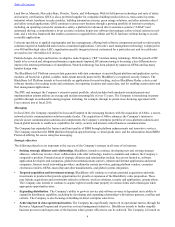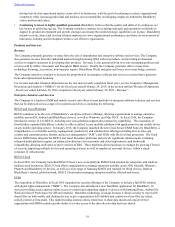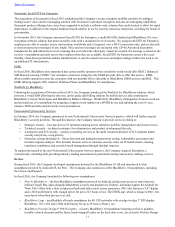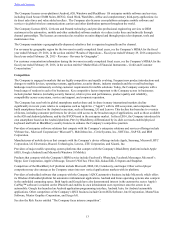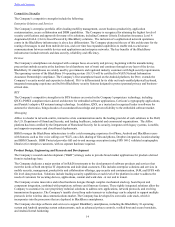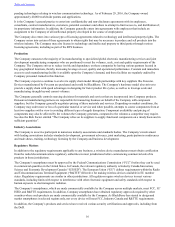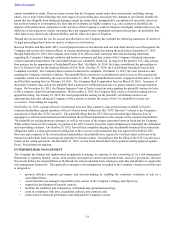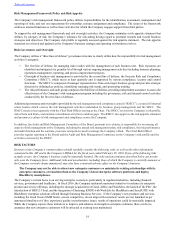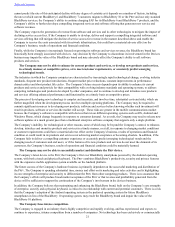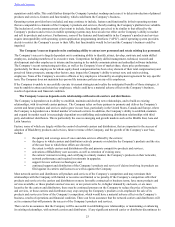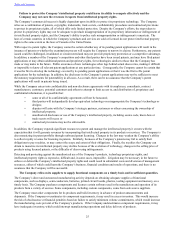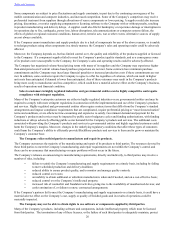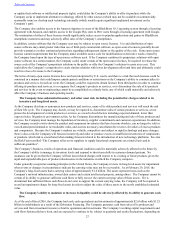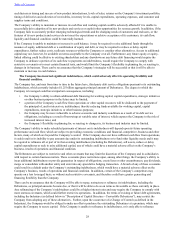Blackberry 2016 Annual Report Download - page 27
Download and view the complete annual report
Please find page 27 of the 2016 Blackberry annual report below. You can navigate through the pages in the report by either clicking on the pages listed below, or by using the keyword search tool below to find specific information within the annual report.
Table of Contents
18
cannot reasonably be made. There are many reasons that the Company cannot make these assessments, including, among
others, one or more of the following: the early stages of a proceeding does not require the claimant to specifically identify the
patent that has allegedly been infringed; damages sought are unspecified, unsupportable, unexplained or uncertain; discovery
has not been started or is incomplete; the facts that are in dispute are highly complex (e.g., once a patent is identified, the
analysis of the patent and a comparison to the activities of the Company is a labour-intensive and highly technical process); the
difficulty of assessing novel claims; the parties have not engaged in any meaningful settlement discussions; the possibility that
other parties may share in any ultimate liability; and the often slow pace of litigation.
Though they do not meet the test for accrual described above, the Company has included the following summaries of certain of
its legal proceedings that it believes may be of interest to its investors.
Between October and December 2013, several purported class action lawsuits and one individual lawsuit were filed against the
Company and certain of its former officers in various jurisdictions alleging that during the period from September 27, 2012
through September 20, 2013, the Company and certain of its officers made materially false and misleading statements
regarding the Company’s financial condition and business prospects and that certain of the Company’s financial statements
contain material misstatements. The individual lawsuit was voluntarily dismissed. In respect of the putative U.S. class actions,
four motions for the appointment of lead plaintiff were filed. On March 14, 2014, the Judge consolidated the proceedings in
the U.S. District Court for the Southern District of New York. On May 27, 2014, the Consolidated Amended Class Action
Complaint was filed. The Company filed a motion to dismiss the complaint. On March 13, 2015, the court issued an order
granting the Company’s motion to dismiss. The plaintiffs filed a motion for reconsideration and for leave to file an amended
complaint, which was denied by the court on November 13, 2015. The plaintiffs filed a notice of appeal on December 11, 2015
and filed their opening brief on February 24, 2016. The Company filed its opposition brief on March 30, 2016. In respect of
the putative Ontario class action, the plaintiffs filed a motion for certification and leave to pursue statutory misrepresentation
claims. On November 16, 2015, the Ontario Superior Court of Justice issued an order granting the plaintiffs’ motion for leave
to file a statutory claim for misrepresentation. On December 2, 2015, the Company filed a notice of motion seeking leave to
appeal this ruling. On January 22, 2016, the court postponed the hearing on the plaintiffs’ certification motion to an
undetermined date after asking the Company to file a motion to dismiss the claims of the U.S. plaintiffs for forum non
conveniens. Proceedings are ongoing.
On October 12, 2015, a group of Good’s institutional investors filed a putative class action lawsuit on behalf of Good’s
common shareholders against members of Good’s former board of directors (the “GTC Directors”) related to the Company’s
acquisition of Good (the “GTC Lawsuit”). The plaintiffs allege that the GTC Directors breached their fiduciary duty by
engaging in a self-interested transaction that benefited the preferred shareholders at the expense of the common shareholders.
The plaintiffs are seeking monetary damages, as well as rescission of the merger agreement between Good and the Company.
While neither Good nor the Company are parties to the GTC Lawsuit, Good has certain obligations to indemnify the defendants
and is providing a defense. On October 29, 2015, Good filed a complaint alleging that the plaintiffs breached their contractual
obligations under a voting agreement providing that, in the event of a sale transaction that was approved by both the GTC
Directors and a majority of the Good preferred shareholders, the plaintiffs were required to vote their shares in favour of the
transaction and refrain from exercising any appraisal or dissenter rights. Good alleges that the filing of the GTC Lawsuit was a
breach of the voting agreement. On December 31, 2015, several Good shareholders filed a petition seeking appraisal against
Good. Proceedings are ongoing.
ENTERPRISE RISK MANAGEMENT
The Company has defined and implemented an approach to manage its exposure to risk, consisting of: (i) a risk management
framework to regularly identify, assess, treat, monitor and report on current and potential risks, and (ii) a governance structure
that clearly defines the responsibilities of the Board, the senior leadership team, employees and other stakeholders to support the
risk management framework. This approach to enterprise risk management is integral to the Company’s business activities and
is designed to:
• promote effective corporate governance and decision-making by enabling the consistent evaluation of risk on a
consolidated basis;
• ensure that risks are managed responsibly in the context of the Company’s strategy and objectives;
• support the development of internal controls;
• facilitate the reliability and transparency of financial and operational reporting;
• assist in compliance with laws, regulations, policies, and contracts; and
• reduce harm to financial performance and safeguard the Company’s assets.



